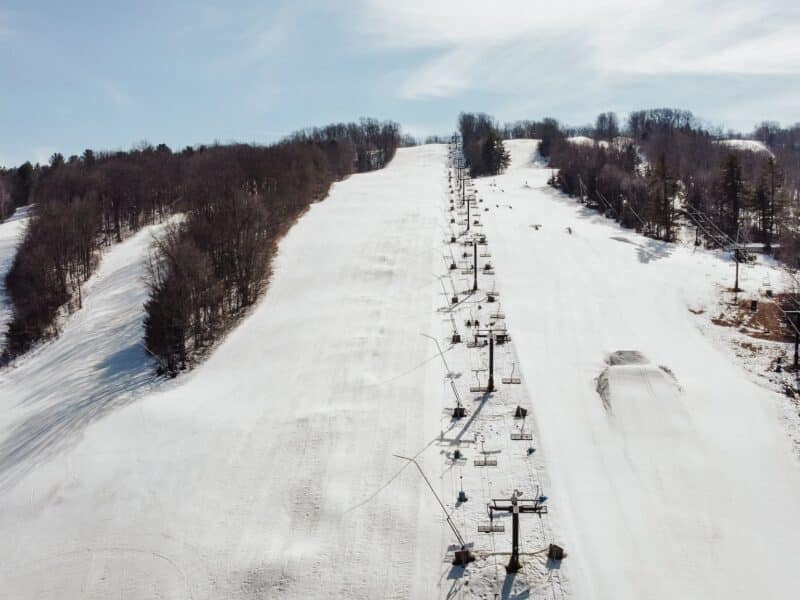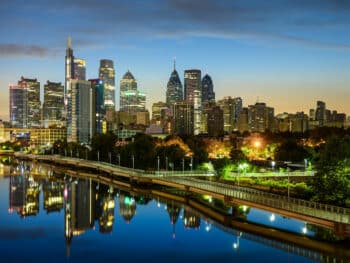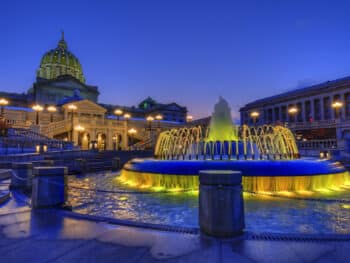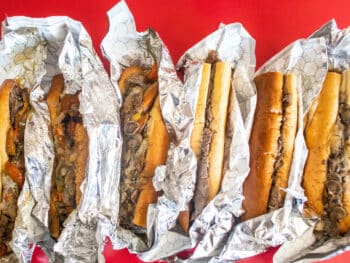In the northeastern region of the United States, Pennsylvania is a historically significant state that was vital in founding the nation’s independence. It’s well known for its role in the Civil War as sights like Gettysburg, as well as famous for its delectable food items including Philly cheesesteaks, Hershey’s chocolate, pretzels, and potato chips, plus the local Amish culture.
As one of the original 13 British colonies, tourism in the state is heavily influenced by the Revolutionary history of the state, which includes historical sites like Independence Hall, Gettysburg, and the Liberty Bell. Aside from Pennsylvania’s ties to the days of early America, the state is also well-known for its natural beauty where nearly 60% of the landscape is forested.
The diverse geography is split between major mountain ranges, rivers, and Lake Erie. An ideal destination for exploring bustling urban areas and natural environments, Pennsylvania has dozens of hotspots for tourists to check out.
Millions of tourists visit this state every year, both from around the US and the globe. With attractions to entertain travelers of all ages, Pennsylvania is an all-encompassing destination for exploring, touring, shopping, dining, and relaxing. A trip to this northeastern state will be impossible to forget.
Livin’ La Vida Pennsylvania
Visit Pennsylvania’s Top Towns and Cities
History of “The Keystone State”

The Pre-Columbian era in Pennsylvania was a time when many American Indian tribes lived on the land. With ancestors tracing back hundreds of years, tribes that lived in the state include the Erie, Iroquois, Lenape, and Shawnee. These tribes were the first to be contacted by Europeans who began their colonization of Pennsylvania as early as 1643.
The Dutch were the first to colonize the state before the English gained control of the colony in 1667. Many of the native people were killed after contact with the English as a result of being exposed to new diseases like smallpox. Pennsylvania’s official period of colonization began in 1681 when William Penn was granted control of the colony by Charles II of England.
Designed to be a place of religious freedom, the colony was home to many Quakers. The name Pennsylvania comes from Latin meaning “Penn’s woods”. In addition to founding the colony, William Penn also founded the colonial capital, Philadelphia, in 1682.
Throughout the centuries, Pennsylvania has attracted many immigrants from various backgrounds including Welsh, German, Scottish, Irish, and French settlers.

During the American Revolution in the 18th century, the state became an important meeting place for the first and second Continental Congresses. It was during the second Continental Congress that the Declaration of Independence was signed in 1776 at Independence Hall. There were also many battles in Pennsylvania during the revolution including major campaigns like the Battle of Gettysburg and Brandywine.
Since the days of the American Revolution, Pennsylvania has expanded to become the 5th most populous state in the United States with more than 13 million residents. Industries that fuel the economy include mining, steelmaking, agriculture, healthcare, and tourism.
Capital City of Harrisburg

Situated on the east bank of the Susquehanna River is Harrisburg, the capital city of Pennsylvania. Originally settled by Native Americans, people are thought to have lived in the area since 3,000 BC. Called “Peixtin” or “Paxtang” by the indigenous people, contact with Europeans first happened during the 17th century when Captain John Smith traveled along the Susquehanna River.
In the city’s earliest days from 1800 to 1850, Harrisburg was known for being a scenic town and most of the landscape was dominated by farmland. It wasn’t until after the American Civil War that it was heavily industrialized with steel and iron production becoming prominent industries.
As the city became less industrial, more neighborhoods and historic districts were built in the Harrisburg metropolitan area.
Currently, there are dozens of large neighborhoods and historic districts throughout the city. One of the main neighborhoods for tourism is Downtown Harrisburg where the Pennsylvania State Capitol Complex and central business areas are located. Other popular areas of the city include East Harrisburg and the Harrisburg Historic District.

A city of 50,069 in 2020, most of the tourism in Harrisburg is centered around the city’s museums and natural attractions along the Susquehanna River. As a historic city, the National Civil War Museum has many in-depth exhibits, which include more than 21,000 wartime artifacts and archives.
For its stunning architecture, a visit to the Pennsylvania State Capitol Complex allows visitors to view precious works of art including statues and murals. Travelers are also encouraged to explore the city’s scenic beauty.
Riverboat tours are a popular activity and there are a few parks just outside of the city center. Wildwood Park has easy-to-navigate trails and is a prime picnic spot during warm weather. To learn more about the history of the city and spend time in the great outdoors, the Fort Hunter Mansion & Park provides guided tours through 40 acres along the Susquehanna River.
Philadelphia, “The City of Brotherly Love”

With the name often shortened to “Philly”, Philadelphia is the largest city in the state of Pennsylvania, supporting a population of 1.601 million in 2020. The city was previously the colonial capital until Harrisburg took its place.
Very popular with tourists, this city is well-known for its historical significance, museums, markets, parks, and cheesesteaks. Philadelphia’s most popular attractions are the Liberty Bell Center and Independence Hall.
Deemed to be the “4th most walkable city in the nation”, tourists don’t have to rely on anything more than their own two feet to explore Philly and all of its attractions. Beyond the shopping and dining venues, the city has a diverse array of activities. From the kid-friendly Philadelphia Zoo or Franklin Institute, visitors might also want to check out the more obscure destinations.
The Mütter Museum is full of medical oddities and the Eastern State Penitentiary once held the notorious gangster, Al Capone. To celebrate the arts, the Philadelphia Museum of Art and Rodin Museum display thousands of classic pieces. Whether you’re looking to take a deep dive into American history or enjoy the city’s social scene, Philadelphia is an impressive destination.
Pittsburgh, “Steel City”

Pennsylvania’s second most populous city is Pittsburgh, also known as “Steel City” because there are hundreds of steel-related businesses in the area. Others call Pittsburgh the “City of Bridges” with 446 bridges connecting the city’s various landscapes.
Situated on the Allegheny Plateau, this city has 90 distinct neighborhoods. For the most part, Pittsburgh is divided into 6 areas called Central, Downtown Pittsburgh, East End, West End, North Side/North Hills, and South Side/South Hills. Downtown Pittsburgh is called the Golden Triangle and it is a major tourist hub because of its cultural district and riverside location.
A few of the top attractions in Pittsburgh include the Carnegie Museum of Art, Carnegie Museum of Natural History, Pittsburgh Zoo and PPG Aquarium, Phipps Conservatory and Botanical Gardens, PNC Park, the Duquesne Incline, the Pittsburgh Skyline Overlook, and Point State Park.
Revolutionary and Civil War History

Pennsylvania is full of historical sites that are significant to the founding of the country. Scattered throughout the state, tourists can head to busy urban areas and small towns to view historic buildings, museums, artifacts, and battlefields.
Beyond the well-known Independence National Historical Park and Gettysburg National Military Park, there are various other locations where tourists can learn more about the American Civil War. Other historical destinations worth visiting include the Valley Forge National Historical Park, Washington Crossing Historic Park, and the Fort Necessity National Battlefield.
All of these sites have their own museums, visitor centers, and exhibits at the locations. A few may also include re-enactments of battle or other special events throughout the year.
Amish Country

Although Pennsylvania is famous for its ties to the Quakers, the Pennsylvanian Dutch brought a variety of religions to the state including Amish, Mennonites, and Brethren. The largest Amish community in the state is in Lancaster County with an estimated 30,000 members of the faith.
Lancaster is a fairly large city (population of 57,712 in 2020), but much of the local draw is driven by outsiders’ curiosity about the Amish community, who live in the county’s countryside. Known for opposing modern technology, tourism has opened a few attractions within the Amish community.
Travelers can experience Amish culture by visiting farms, taking horse and buggy tours, or touring an Amish village. Many people will also visit the Amish countryside to purchase Amish goods like handmade furniture, produce, and various Amish artistry crafts like quilts.
Pristine Pennsylvanian Wilderness

The Pennsylvanian wilderness is vast and it encompasses more than 2 million acres of public land. From state land and forests to national areas, this state beckons travelers to explore its rugged mountains, roaring rivers, and dense forests.
The Delaware and Susquehanna Rivers are large bodies of water in the state, while the Appalachian and Pocono Mountain Ranges add diversity to Pennsylvania’s landscapes.
Visitors are encouraged to get out and explore some of the state’s quieter attractions where the sounds of nature provide the perfect soundtrack for hiking, biking, cycling, wildlife watching, boating, fishing, hunting, and downhill skiing.
Pennsylvanian Cuisine

For many, Pennsylvania has become famous for its cuisine. From full meals to easy snacks, tourists won’t want to miss testing out their taste buds during their trip to the Keystone State. It’s the “Snack Capital of the World”.
Pennsylvania’s soft and hard pretzels have become world-famous snacks that are sold in national chains and exported abroad. Auntie Anne’s is the most popular soft pretzel chain in the country. You can find the hard pretzels of Snyder’s (of Hanover) on grocery shelves across the country, as you can some PA potato chip brands like Utz.
Famous in Philadelphia and beyond are the cheesesteaks where you can choose between a few varieties and toppings. There’s also Hershey chocolate, which was founded in Lancaster before moving its headquarters to an unincorporated community aptly named Hershey.
These are just a few out of dozens of tasty treats that can be found in Pennsylvania. When dining out or walking through markets, tourists should definitely indulge themselves in tasting some of the incredible local cuisines.
Pleasant Pennsylvania

A diverse destination full of fun, educational, and interesting activities, Pennsylvania is one place that you won’t want to miss when exploring the East Coast of the United States. Intriguing to travelers of all ages, visitors can personalize their itinerary to see the best local cities, towns, history, culture, and nature. No matter where you go in this state, it will captivate you.
If you find yourself in Western PA near the town of Everett, you can stop by Pennsylvania’s hot springs for a soak.
Latest in Pennsylvania

7 Closest Ski Resorts by Baltimore, Maryland
Baltimore is well known for its history, blue crabs, and sports teams, but not necessarily as…

12 Closest Ski Resorts by Cleveland, Ohio
There are plenty of reasons why Cleveland rocks, whether it’s the many sports teams, the Rock…

9 Closest Ski Resort by Buffalo, New York
New York has more ski areas than any other state, yet, with most resorts to the…

9 Closest Ski Resorts by Pittsburgh, PA
For those looking to hit multiple ski resorts this winter, staying in Pittsburgh is a convenient…
View more Pennsylvania articles
















 11 Top Historical Sites by Harrisburg, Pennsylvania
11 Top Historical Sites by Harrisburg, Pennsylvania